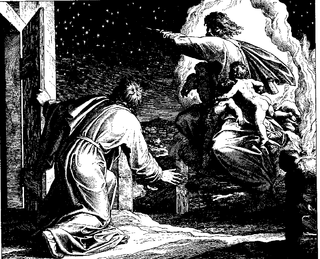 W
WAnimal sacrifice is the ritual killing and offering of an animal, usually as part of a religious ritual or to appease or maintain favour with a deity. Animal sacrifices were common throughout Europe and the Ancient Near East until the spread of Christianity in Late Antiquity, and continue in some cultures or religions today. Human sacrifice, where it existed, was always much more rare.
 W
WAccording to the Hebrew Bible, the covenant of the pieces or covenant between the parts was an event in which God revealed himself to Abraham and made a covenant with him, in which God announced to Abraham that his descendants would eventually inherit the Land of Israel. This was the first of a series of covenants made between God and the biblical patriarchs.
 W
WGadhimai festival was a sacrificial ceremony that was held every 5 years at the Gadhimai Temple of Bariyarpur, in Bara District, about 100 miles (160 km) south of the capital Kathmandu, and about 4.35 miles (7.00 km) east of headquarter of Bara district kalaiya city, in the southern Nepal, near the Indo-Nepal border, adjacent to Bihar. It is primarily celebrated by the Madheshi people. The event involves the large-scale sacrificial slaughter of animals including water buffaloes, pigs, goats, chickens, and pigeons – with the goal of pleasing Gadhimai, the goddess of power. People also offer coconuts, sweets, red colour clothes, etc.
 W
WThe modern practice of Hindu animal sacrifice is mostly associated with Shaktism, and in currents of folk Hinduism strongly rooted in local popular or tribal traditions. Animal sacrifices were part of the ancient Vedic religion in India, and are mentioned in scriptures such as the Yajurveda. Some Puranas forbid animal sacrifice.
 W
WMany Indo-European religious branches show evidence for horse sacrifice, and comparative mythology suggests that they derive from a Proto-Indo-European (PIE) ritual.
 W
WIyomante (イヨマンテ) is an Ainu ceremony in which a brown bear is raised for two years then sacrificed. The word literally means "to send something/someone off". In some Ainu villages, it is a Blakiston's fish owl, rather than a bear, that is sacrificed. In Japanese, the ceremony is known as "sending off the bear" or, sometimes, "the bear festival" .
 W
WKapparot is a customary atonement ritual practiced by some Jews on the eve of Yom Kippur. This is a practice in which a chicken or money is waved over a person's head and the chicken is then slaughtered in accordance with halachic rules.
 W
WLustratio was an ancient Greek and ancient Roman purification ritual. It included a procession and in some circumstances the sacrifice of a pig (sus), a ram (ovis), and a bull (taurus) (suovetaurilia).
 W
WThe Lychee and Dog Meat Festival is an annual festival held in Yulin, Guangxi, China, during the summer solstice in which festival goers eat dog meat and lychees. The festival began in 2009 and spans about ten days during which thousands of dogs are reportedly consumed. The festival has drawn criticism both domestically and abroad.
 W
WIn Armenian Christian tradition, matagh is a lamb or a rooster slated for sacrifice to God, a ritual which has continued from the pagan past. In many regions of Armenia today, this practice is very much alive in the regular slaughter of chosen animals in front of churches. Matagh is done often to ask God for either forgiveness, health, or to give him something in return. People generally gather at the house where the Matagh was done, where they pray and eat the meat. Tradition holds that the meat must be eaten before sundown.
 W
WIn the Roman Empire of the second to fourth centuries, taurobolium referred to practices involving the sacrifice of a bull, which after mid-second century became connected with the worship of the Great Mother of the Gods; though not previously limited to her cult, after AD 159 all private taurobolia inscriptions mention the Magna Mater.
 W
WUmkhosi Wokweshwama [um̩kʰoːsi woɠʷeʃʷaːma], recently also known as Umkhosi Woselwa [um̩kʰoːsi woseːlʷa], is the annual harvest festival of the Zulu people, observed around the December solstice. It takes place at the Enyokeni Royal Palace in Nongoma, KwaZulu-Natal, and is presided over by the Zulu King, who conducts a tasting ceremony as sacred king, closed by the dashing of a calabash to signify that the people may now enjoy the fruits of the harvest; this role was historically expanded by Shaka to have more military significance with a muster and parade. It was revived by the current king Goodwill Zwelithini kaBhekuzulu in 1990, after a ban by British colonial authorities following the 1879 Battle of Isandlwana and Zulu defeat in the Anglo-Zulu War.